Halloween marks the one year anniversary of the Analog Gamer series on Tor.com. One of the nice things about board and card games is that they have much longer shelf lives than video or computer games. Video games tend to become instantly obsolete as soon as a sequel is released and even without sequels technology passes them by in two or three years, a good board or card game on the other hand can retain its play value for decades. With that in mind, I stand by my 2010 list of Halloween games and offer this new list not as a replacement but as a supplement to those titles.
Elder Sign
If you watched at least 30 seconds of the video you know that Fantasy Flight Games is getting really good at bringing Cthulhu to life (let’s hope I’m being figurative). Elder Sign is now the third title in FFG’s unholy trinity of Lovecraft inspired board games including Arkham Horror and Mansions of Madness and is by far the most accessible of the three. Fantasy Flight also publishes a well respected Call of Cthulhu card game using their Living Card Game (LCG) format.
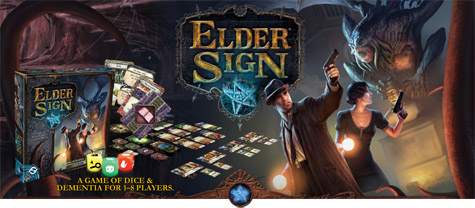
Elder Sign is a cooperative game for 1 to 8 players designed by Richard Launius, the same designer that brought us Arkham Horror. The video does a good job of describing gameplay and a preview can also be found in my post about SFF Dice Games here on Tor.com. Elder Sign has been out for about a month and I’m happy to report this is a solid game. It doesn’t provide the full Arkham Horror/Mansions of Madness experience but at two hours playing time with very little setup it has already been played more frequently by my group and is universally enjoyed. At less than $25 (online pricing) it is also a bargain.
Do you want your Lovecraftian terror to-go? Following a growing trend in the board gaming industry, Fantasy Flight Games has announced Elder Sign: Omens, an adaptation of Elder Sign for mobile devices. The standard version for iPhone and Android will be available for $3.99, an HD version will be available for $6.99 for the iPad and Max OS X.
Mansions of Madness
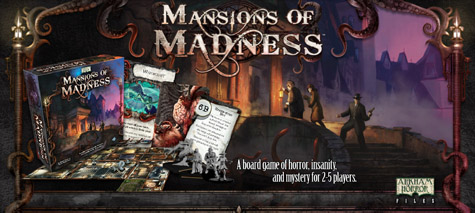
A cryptic note from a missing colleague warns of sinister midnight rituals in an old monastery outside of Dunwich, a business man worries just how far his partner is willing to go to save the life of his sick child, a green-eyed boy lures investigators into an unwilling game of hide-and-seek in a mysterious mansion this is the stuff Mansions of Madness is made of, a Lovecraft adventure game for 2 to 5 players designed by Corey Konieczka (Battlestar Galactica) and published by Fantasy Flight Games.
I won’t get into the details of gameplay, Dan Wells has already posted an excellent review here on Tor.com. I will report that after about nine months and many play sessions, Mansions of Madness is still great fun. Sure, it’s got some issues; the setup takes forever, one of the scenario options is genuinely broken, and I wish there was more variety in the combat decks but warts, boils, tentacles and all Mansions of Madness is by far the best Cthulhu board game experience available and I strongly recommend it. I like all of FFG’s Lovecraft games but more than any other game Mansions of Madness can produce stories of last ditch heroic efforts, betrayal, and stunning defeats that players will repeat even months later.
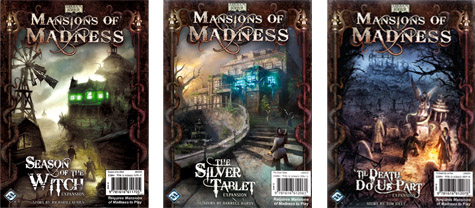
So, what’s new for Mansions of Madness fans? Not unexpectedly Fantasy Flight Games has started to roll out the expansions. The first three expansions use FFG’s new print-on-demand method of distribution. These are small, single scenario adventure packs that can be released quickly and relatively cheaply (about $15 each). The adventure packs include cards, setup sheets, and rules unique to each scenario. In Season of the Witch investigators must unravel the mystery behind the generations old disappearance of a bright young Miskatonic University student from a boarding house, now crumbling into decay and rumored to play host to a coven of witches. In The Silver Tablet investigators are hired to discreetly recover an ancient artifact stolen from the university by a promising professor. Til Death Do Us Part jumps off from a quiet pub in Innsmouth and quickly spirals into a web of ancient rituals and dark rumors of human reanimation where the investigators may have to enlist the help of some unusual allies.
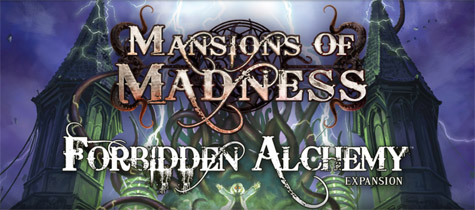
The big news for Mansions of Madness is the announcement of Forbidden Alchemy. This expansion will be sold in a standard retail box for $34.95 and should be in stores by December (hopefully). It will contain 3 new scenarios, 8 plastic figures, 6 map tiles, many new cards, new puzzles, and new or expanded rules including side effects, mutations, and even time travel. As a fan of the game this expansion is sitting at the top of my Christmas list.
Grave Business
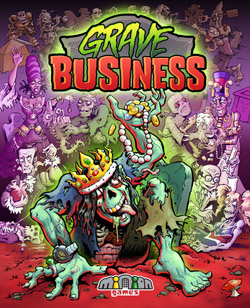 Who says digging up old graves can’t be both fun and profitable? In fact, it’s so profitable everyone wants in on the business. In Grave Business players take the roles of mad scientists feverishly building armies of zombies and sending them into the cemetery to dig up the most valuable trinkets and choice body parts while defending their claims against other mad scientists attempting to do the same.
Who says digging up old graves can’t be both fun and profitable? In fact, it’s so profitable everyone wants in on the business. In Grave Business players take the roles of mad scientists feverishly building armies of zombies and sending them into the cemetery to dig up the most valuable trinkets and choice body parts while defending their claims against other mad scientists attempting to do the same.
Grave Business features a ton of player interaction. Zombies can be positioned to compete for treasure in the cemetery, steal treasure from other players, and occasionally sent to dismember other player’s zombies to gain tactical advantage. Treasure in the cemetery includes trinkets with various point values and also corpse parts that can be saved for points or used to build additional zombies to do the player’s bidding. Zombie construction is one of the more interesting aspects of the game. Players can build small, weak zombies but get them out quickly or they can take their time to build enormous and very dangerous monstrosities. The cemetery also includes a few items that can be equipped on a zombie for some interesting effects.
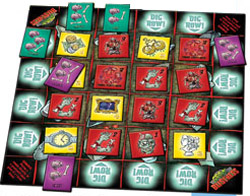 Grave Business was designed by Andy Van Zandt, published by Minion Games, and can be completed in about 45 minutes. The box says 2 to 4 players but I strongly recommend playing with a full complement of four. Grave Business can be found in full service game stores and online for about $30.
Grave Business was designed by Andy Van Zandt, published by Minion Games, and can be completed in about 45 minutes. The box says 2 to 4 players but I strongly recommend playing with a full complement of four. Grave Business can be found in full service game stores and online for about $30.
Puppet Wars
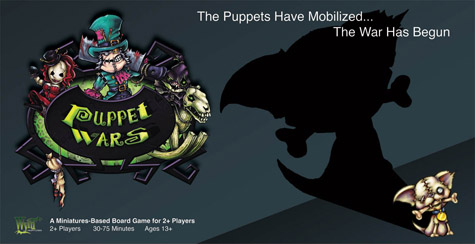
For years, whenever Zoraida has left her hut on some baleful errand, the Bayou has pricked up its green and fetid ears to the muffled sounds of the smallest of wars coming from inside the wooden walls. Small, yes, but vicious and without equal. A war of cloth and stuffing, of stitches and magic, of buttons and patches, of needles and thread. If you listen very, very carefully, you can hear the puppets fighting.
When Zoraida opened the door, nothing was left to suggest a furious battle had been waging only moments before. Nothing, that is, but a lone puppet in green cloth lying beside his own severed head. The other puppets lay motionless in the wooden boxes, terrified their exploits would be discovered. In the rush, no one had remembered to pick up Seamus. But Zoraida did not seem puzzled, or even concerned. She picked him up and, tutting and mumbling to herself, sewed him back together and placed him carefully with the others.
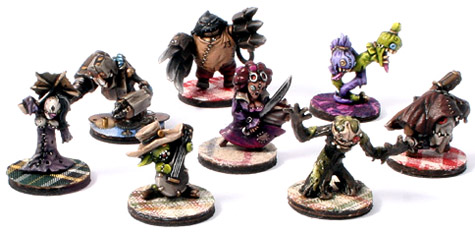
I’ve included this long (but very much abridged) quote from the Puppet Wars rule book because to appreciate Puppet Wars you need to appreciate the dark and twisted world from which it is drawn. Puppet Wars is a board game incorporating miniatures and cards set in a very small corner of the strange mix of gothic horror, steampunk, dark magic, and old west that is Malifaux (see this post for more on Malifaux).
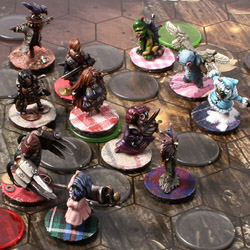 In Puppet Wars players control master puppets that can conjure lesser puppets from toy boxes to do battle for workbenches and other objectives within Zoraida’s workshop. Like its larger scale brethren, each puppet in Puppet Wars has an extensive back story and list of special abilities that interact with other puppets in interesting combinations. Understanding these interactions allow players to fill their toy boxes with effective fighting forces before battle. In addition to special abilities, when puppets are destroyed (or shredded) they leave behind upgrades that can be sewn onto puppets of any side for increased mayhem. Puppet battles can take anywhere from 30 minutes to an hour and a half depending on the number of puppets involved.
In Puppet Wars players control master puppets that can conjure lesser puppets from toy boxes to do battle for workbenches and other objectives within Zoraida’s workshop. Like its larger scale brethren, each puppet in Puppet Wars has an extensive back story and list of special abilities that interact with other puppets in interesting combinations. Understanding these interactions allow players to fill their toy boxes with effective fighting forces before battle. In addition to special abilities, when puppets are destroyed (or shredded) they leave behind upgrades that can be sewn onto puppets of any side for increased mayhem. Puppet battles can take anywhere from 30 minutes to an hour and a half depending on the number of puppets involved.
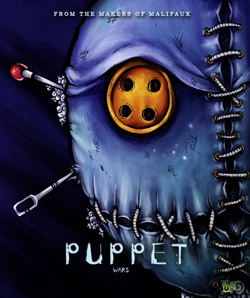 Puppet Wars isn’t exactly cheap. The starter set retails for $85 with 18 puppet miniatures and enough components for 2 players. A $32 multiplayer expansion is required to increase the player count to 4. There are also currently 3 booster packs with 8 figures each that increase puppet variety and replayability.
Puppet Wars isn’t exactly cheap. The starter set retails for $85 with 18 puppet miniatures and enough components for 2 players. A $32 multiplayer expansion is required to increase the player count to 4. There are also currently 3 booster packs with 8 figures each that increase puppet variety and replayability.
The world of Malifaux and by extension Puppet Wars is rich and incredibly interesting. The integration of theme and mechanics is absolutely fantastic. Unfortunately, this richness feels like both a blessing and a curse. As an outsider to both games I found Puppet Wars assumed some familiarity and emotional investment to the characters that I didn’t necessarily bring to the table. For this reason and the relatively high price point I think Puppet Wars will be most popular with Malifaux players looking for a change of pace, and also as a vehicle for experienced players to introduce outsiders to their hobby.
Spectral Rails
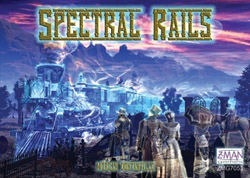 In Spectral Rails players conduct ghost trains traveling through America’s Old West competing to pick up the most lost souls and deliver them to their final resting places. Spectral Rails is a unique train game for 3 to 4 players designed by Morgan Dontanville and published by Z-Man Games that plays in about 75 minutes.
In Spectral Rails players conduct ghost trains traveling through America’s Old West competing to pick up the most lost souls and deliver them to their final resting places. Spectral Rails is a unique train game for 3 to 4 players designed by Morgan Dontanville and published by Z-Man Games that plays in about 75 minutes.
In a very interesting twist on other rail games, the ghost trains in Spectral Rails travel invisible routes between towns leaving behind trails of ethereal tracks which gradually dissipate as memory of the ghost trains fade. Ghost trains move quickly and efficiently over other player’s tracks but may never move back over their own. This produces an interesting game of maneuver where players try to exploit each other’s tracks while trying to insure the track they leave behind is as little use as possible.
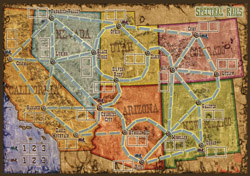 The premise is fantastic and the gameplay is both unique and fun, unfortunately the scoring feels a little underdeveloped. Final scores in Spectral Rails are often very close, so close that the difference between placing first and last is determined more by luck of the passenger draw than good play. With that deficiency in mind I’d call Spectral Rails a good game but I’d stop short of calling it great. If you can overlook the scoring issues Spectral Rails is actually a bargain for games of this type and can be purchased online for about $25.
The premise is fantastic and the gameplay is both unique and fun, unfortunately the scoring feels a little underdeveloped. Final scores in Spectral Rails are often very close, so close that the difference between placing first and last is determined more by luck of the passenger draw than good play. With that deficiency in mind I’d call Spectral Rails a good game but I’d stop short of calling it great. If you can overlook the scoring issues Spectral Rails is actually a bargain for games of this type and can be purchased online for about $25.
Cthulhu Gloom
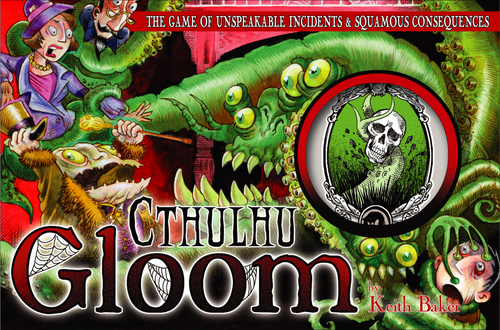
The original Gloom was on last year’s Halloween list and Cthulhu Gloom is pretty much the same game with Cthulhu art and flavor text. Each player tries to drive their own five cultists as insane as possible by exposing them to knowledge that should never be revealed, ultimately sacrificing them to the elder gods to lock in their scores. While tormenting their own cultists players strive to keep the cultists belonging to everyone else happy, sane, and most importantly, alive.
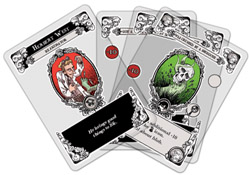 I’m a fan of the original Edward Gorey style of art and I don’t see much reason to own two copies of what is essentially the same game, but, if you’re a Lovecraft fan and don’t already own the earlier version this game is definitely worth investigating. Cthulhu Gloom was designed by Keith Baker (Gloom), published by Atlas Games, and can be played in about 1 hour. Cthulhu Gloom can be found in full service games stores and online for about $17.
I’m a fan of the original Edward Gorey style of art and I don’t see much reason to own two copies of what is essentially the same game, but, if you’re a Lovecraft fan and don’t already own the earlier version this game is definitely worth investigating. Cthulhu Gloom was designed by Keith Baker (Gloom), published by Atlas Games, and can be played in about 1 hour. Cthulhu Gloom can be found in full service games stores and online for about $17.
When not hiding from elder gods, Bob Gallo is a computer programmer specializing in Flash and interactive application design living in the Charlotte, NC area. Bob got his gaming start in the mid 1970s with traditional hex-and-counter war games and has played nearly all types of games including role playing games, miniatures, collectible card games, video/PC games as well as traditional board and card games.










